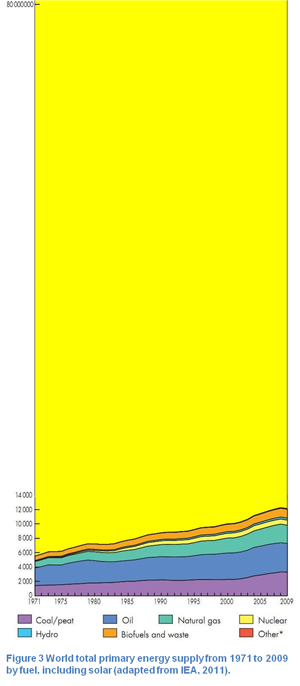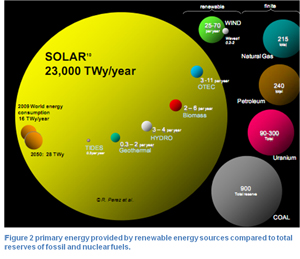Time to re-appraise the IEA's energy statistics
on
Time to re-appraise the IEA's energy statistics
The International Energy Agency and other established institutions come to mistaken conclusions about our energy future because they rely on a paradigm that fails to take into account the real potential of renewable energy. As a result, the transition to a sustainable energy future that the world is making is seriously hampered, argues Rick Bosman.
 |
| Figure 3: the IEA's graph on world total primary energy supply 'repaired' by including the sun |
The United Nations General Assembly has declared 2012 the International Year of Sustainable Energy for All. In order to achieve this noble goal there are several obstacles that need to be overcome. Energy experts differ on what these are. Some say costs of renewable energy need to come down, others say government should cut red tape, e.g. streamline planning and permitting procedures for wind parks, and again others say it's the fossil fuel lobby that is so powerful that it is impossible to change anything. I think there is some truth in all of these points, but I believe the main obstacle to achieving real change is the way we look at energy. It is important to realise that information is never neutral. The way information is presented tends to cement current paradigms. Therefore, if we are serious about achieving sustainable energy for all, we should fundamentally rethink the way we view and present energy information.
That's how we've always done it
The energy sector has in most places been dominated by large centralised fossil or nuclear power production facilities that produce energy which is then transported to users through extensive grids. Concerns over climate change, resource availability and security and the availability of clean and more decentralised alternatives have led different groups to increasingly question this dominant structure. Change however is only developing slowly, at least slower than some hope for. With a simple example I'd like to show that the reason for this is not (only) that fossil fuel interests are actively trying to stall the energy transition, but that certain fixed ways of thinking about energy, deeply embedded in the culture, structure and practices of the established energy institutions, are preventing the necessary steps to move to a sustainable energy system.
I am convinced that the most powerful enemy of change is to be found in those trivial rules that are so basic to the game, that no one even thinks of them, let alone proposes changing them. This phenomenon is very human, but it can have disastrous effects. The financial sector, like the energy sector currently under much public scrutiny, uses the term 'capture' to describe a situation where analysts - professionals that are trained to see
| I believe the main obstacle to achieving real change is the way we look at energy |
Really, why?
One of the ways to overcome this problem is to ask regular feedback from outsiders, people that are able to provide a fresh perspective on the situation. They may not know all the ins and outs of a sector, but at least they don't suffer from 'capture'.
With this in mind, let's consider the International Energy Agency's Key Energy Statistics. The IEA is an important source of energy information and its publications can be found on the bookshelf of any self-respecting energy expert. In its own words the agency 'is at the heart of global dialogue on energy, providing reliable and unbiased research, statistics, analysis and recommendations.'
Figure 1 is a graph from the IEA's 2011 Key Energy Statistics that shows the development of the world's total primary energy supply over the last four decades. According to the glossary of the Key Energy Statistics, the definition of total primary energy supply is the following: 'Total primary energy supply (TPES) is made up of production + imports - exports - international marine bunkers - international aviation bunkers ± stock changes.' This is not really a definition, but rather a description of how the unit was put together. A quick Wikipedia-search gives us the following definition of primary energy: 'an energy form found in nature that has not been subjected to any conversion or transformation process. It is energy contained in raw fuels, and other forms of energy received as input to a system.' World total primary energy supply, then is the total amount of energy found in nature across the globe over a certain time period.
 |
| Figure 2: Primary energy provided by renewable energy resources compared to total reserves of fossil and nuclear fuels (click to enlarge) |
The result is perhaps unfortunate from a layout perspective, but I would argue that my graph provides a more accurate picture of the world's total primary energy supply than the IEA's.
Moreover, I believe that if the IEA and other organisations start including renewable energy sources in their data in this way, it would fundamentally change the energy debate. For one thing, it would immediately become clear how ridiculous recent discussions about 'the energy crisis' are. Looking at figure 2 or 3, there obviously is no such thing as an energy crisis. Rather there is a mental crisis
| There obviously is no such thing as an energy crisis |
Taking this line of thought further, I could make a similar argument for representing 'total final consumption'. According to the IEA, 'total final consumption (TFC) is the sum of consumption by the different end-use sectors.' However, looking at the IEA's graph (see figure 4) it becomes clear that some forms of energy consumption everyone enjoys daily, such as day-light, 'passive' heating of houses and offices, free ventilation services through pleasant breezes, apparently do not count. Again, I believe that including these 'trivial' forms of energy consumption would fundamentally change the way we view and handle energy issues.
Pause for a moment
Analytically, leaving out these forms of energy is a pity, because it is inaccurate. From a societal point of view however, it's disgraceful. It has serious consequences for humanity, as these statistics form the point of reference for everyone that is somehow involved in energy issues. Thereby, it influences how the problem is defined and in what direction we look for possible solutions. Do we drill our way out of an energy crisis? Or do we pause for a moment, rethink the standard way to look at energy and start harvesting the energy the sun sends us?
In this article I focused on graphs from the IEA, but the same argument could be made for other leading publications such as BP's yearly Statistical Review of World Energy. Why these forms of energy supply and consumption are left out is unclear. Maybe because they are so basic and trivial that no one notices them, maybe because they are difficult to measure, maybe because they mess up the graphs. Whatever the reasons, what is clear that these forms of energy supply and consumption don't show up in the world's most widely used and renowned energy statistics.
Personally, I don't believe that the IEA and other organizations purposely misrepresent energy supply and consumption to prevent change. I think they simply take their way of reporting, which has evolved over decades, for granted. It has become the standard, the benchmark of the sector. But I suggest that if the IEA and its fellow organisations would like to stay 'at the heart of global dialogue on energy, providing reliable and unbiased research, statistics, analysis and recommendations' and play a role in providing sustainable energy for all, they should start by reconsidering the way they look at and present their energy information.
|
About the author Rick Bosman is MSc-student Renewable Energy Management at the Albert-Ludwigs Universität Freiburg, intern at the Dutch Research Institute for Transitions (Drift) and founder of the Energy Transition Blog. Twitter: @r_bosman Recommended literature: Grin, J., J. Rotmans and J. Schot, 2010. Transitions to sustainable development: new directions in the study of long term transformative change. Routledge, New York / London |


Discussion (0 comments)